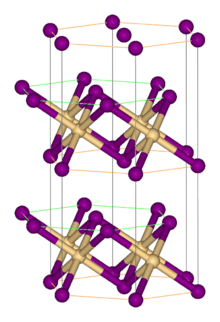
| |
| Names | |
|---|---|
| IUPAC name
Zirconium(IV) sulfide
| |
| Identifiers | |
3D model (JSmol)
|
|
| ChemSpider | |
| ECHA InfoCard | 100.031.701 |
| EC Number |
|
PubChem CID
|
|
CompTox Dashboard (EPA)
|
|
| |
| |
| Properties | |
| ZrS2 | |
| Molar mass | 155.356 g/mol |
| Appearance | red-brown crystals |
| Density | 3.82 g/cm3 |
| Melting point | 1,480 °C (2,700 °F; 1,750 K) |
| insoluble | |
| Structure | |
| Rhombohedral, hP3 | |
| P-3m1, No. 164 | |
| octahedral | |
| Hazards | |
| Safety data sheet (SDS) | MSDS |
Except where otherwise noted, data are given for materials in their standard state (at 25 °C [77 °F], 100 kPa).
| |
Zirconium(IV) sulfide is the inorganic compound with the formula ZrS2. It is a violet-brown solid. It adopts a layered structure similar to that of cadmium iodide.
Like the closely related titanium disulfide, ZrS2 is prepared by heating sulfur and zirconium metal. It can be purified by vapor transport using iodine.[2]
References[edit]
- ^ Lide, David R. (1998), Handbook of Chemistry and Physics (87 ed.), Boca Raton, Florida: CRC Press, pp. 4–96, ISBN 0-8493-0594-2
- ^ Lawrence E. Conroy "Group IV Sulfides" Inorganic Synthesis 1970, XII, 158. doi:10.1002/9780470132432.ch28
Well, that’s interesting to know that Psilotum nudum are known as whisk ferns. Psilotum nudum is the commoner species of the two. While the P. flaccidum is a rare species and is found in the tropical islands. Both the species are usually epiphytic in habit and grow upon tree ferns. These species may also be terrestrial and grow in humus or in the crevices of the rocks.
View the detailed Guide of Psilotum nudum: Detailed Study Of Psilotum Nudum (Whisk Fern), Classification, Anatomy, Reproduction